Before HollandPTC (Holland Proton Therapy Centre) officially opens early next year, Delta was shown around. “We need to demonstrate that protons are the best, according to the rules.”
“You cannot simply drill a hole and pull a cable through here,” quips clinical physicist Nienke Holtzer. She is not exaggerating. We are zigzagging through a maze of hallways with 3-metre-thick concrete walls, making our way to the heart of the proton clinic.
We walk through the catacombs of HollandPTC. At a solid pace, Holtzer leads us to the cyclotron. She is carrying a sensor that records how much ionising radiation we encounter.
The superconductive cyclotron looms up at the end of the corridor. A giant: the size of a tank and twice as heavy
All of that concrete – six metres in total, due to the winding layout of the corridors – is designed to protect the outside world from radiation from the particle accelerator, which spits out protons at two thirds of the speed of light. Well, it does when it’s turned on. It is now at rest – not a common occurrence and the ideal time to show journalists around.
The superconductive cyclotron looms up at the end of the corridor. A giant: the size of a tank and twice as heavy. To get the 90-tonne particle accelerator into place, one of Europe’s largest cranes was erected on the building site last year, on campus behind the Reactor Institute Delft.
In the distance, experts tinker with the tube emerging from the cyclotron. There is a sense of urgency, the clinic opens its doors in a few months’ time. The tube is surrounded by electromagnets. The magnets collect the protons and shepherd them to the treatment rooms.
HollandPTC, founded by Erasmus MC, the Leiden University Medical Centre and TU Delft, will be the first proton clinic in the Netherlands. In addition to Delft, Groningen and Maastricht will also get their own proton therapy centres.
The outpatient centre will also facilitate scientific research into the effectiveness of the therapy, imaging and how materials behave in proton bundles.
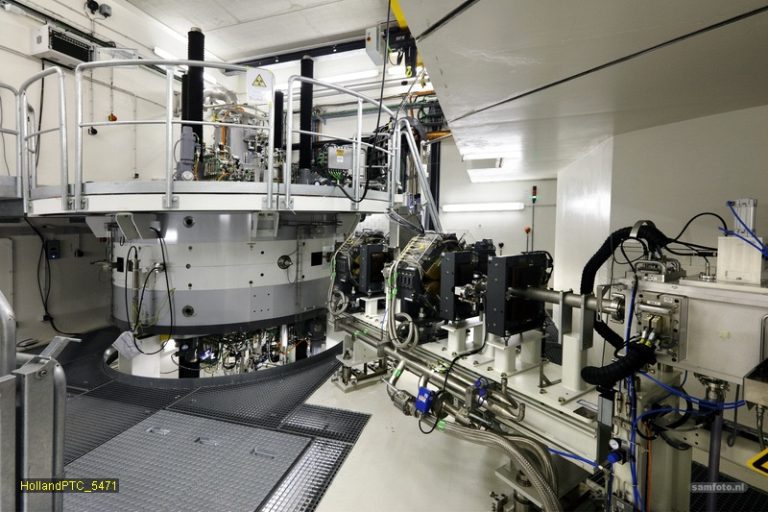 The superconductive cyclotron is a giant. (Photo: Sam Rentmeester)
The superconductive cyclotron is a giant. (Photo: Sam Rentmeester)For Dr Dennis Schaart, Head of the new Medical Physics & Technology research section (AP) and linked to HollandPTC, the opening cannot come soon enough. He is TU Delft’s ‘proton quartermaster’.
“I have been working in medical physics for nearly 20 years now,” says Schaart. “The potential is in the details. Having a clinic on campus is new for us, and added to that, this clinic is for highly technical treatments. We will soon have a physical location where doctors and physicians can work together. Ideas are born at the coffee machine that would not see the light of day behind desks.”
Schaart is convinced of the added value of proton therapy. “That is purely down to the inherent physical logic. With the Bragg peak.”
Time for a brief explanation. Photons release a large amount of their energy as soon as they are beamed into the body. That means that the area in front of the tumour is exposed to a heavy dose. But in contrast, with protons, a limited amount of energy is released directly under the skin. The release increases exponentially towards a sharp peak, the Bragg peak, named after the man who discovered it – Henry William Bragg. By varying the amount of energy in the bundle, the depth of the peak can be altered, thereby tailoring the energy release to the tumour.
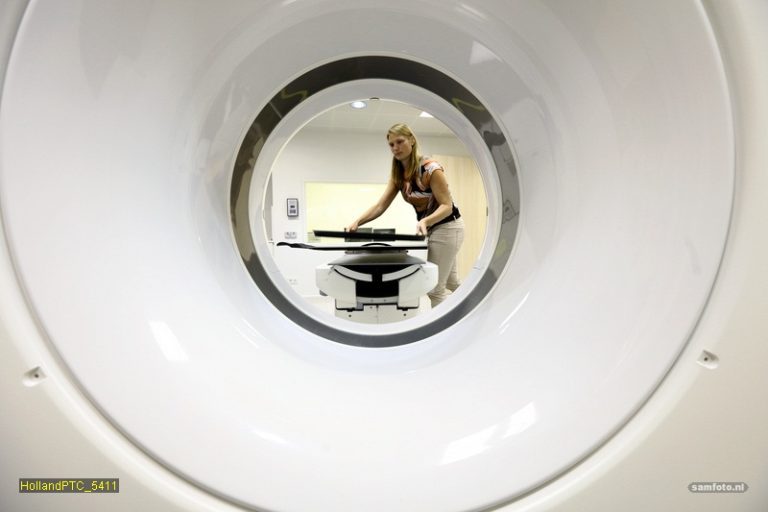 “This is the first time that I will experience the entire process from the beginning; configuring the equipment and drafting the protocols,” says clinical physicist Nienke Holtzer. (Photo: Sam Rentmeester)
“This is the first time that I will experience the entire process from the beginning; configuring the equipment and drafting the protocols,” says clinical physicist Nienke Holtzer. (Photo: Sam Rentmeester)Outside of the Netherlands, proton therapy is primarily used on patients with tumours in tissue that is especially vulnerable to radiation, such as the brain and around the eyes. Protons are also said to be less harmful for children. They have lots of proliferating cells that are additionally sensitive to radiation.
However, there is still no definitive proof that protons are better than photons. This will only be available once years have been spent treating thousands of patients in accordance with strict protocols that are identical at numerous clinics.
“We need to demonstrate this added value according to the rules. We will therefore be working closely with the other proton clinics in the Netherlands,” says Schaart. “What’s more, one of TU Delft’s roles is to further increase this added value. There is potential for improvement in areas such as imaging. We are researching 4D imaging, so including time. We want to be able to see the tumours and the Bragg peak of the protons during radiation. Measuring and regulating: two of our fortes at TU Delft.”
A green light is illuminated close to the cyclotron. Surprisingly enough, ‘Area Insecured’ is the text next to the light. “Don’t worry,” says Holtzer. “That means that the area is no longer secured, because people are here. So the cyclotron cannot be started.”
The tube coming out of the cyclotron makes a sharp left turn after a couple of metres. To the right, there is a wall covered in a thick layer of baryte. The protons that cannot take the bend crash into this wall.
“We have to purify the proton beam,” explains Holtzer. “It is a ‘dirty’ bundle comprised of particles travelling at different speeds. The bend in the tube ensures that only the particles with the desired speed remain.”
Back outside, the radiation sensor indicates 1 μSv, comparable to the amount of radiation you would encounter in the fresh air.
Phantom testing
There are exciting times ahead for Holtzer and her colleagues. “This is the first time that I will experience the entire process from the beginning; configuring the equipment and drafting the protocols,” says Holtzer. “We have recruited several international experts with previous experience of protons. And we have completed training at proton clinics in Baltimore in the US, and in Trento in Italy. Their equipment is just like ours.”
That being said, clinical physicist Petra Trnkova – one of the international experts, emphasises that it is not plug and play. Until recently, she worked on proton therapy at the Paul Scherrer Institute in Switzerland.
“We need to properly calibrate and test the machines,” says Trnkova. “We use phantoms for this – objects that simulate patient tissue.”
In the first year, the doctors in Delft will primarily treat patients with head and neck tumours. “We expect proton therapy to offer added value to a specific group of patients with tumours in this area,” says Holtzer.
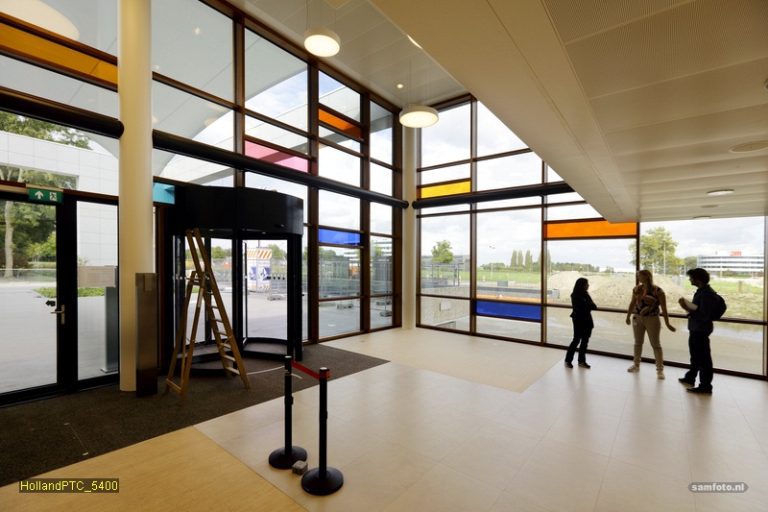 Majella de Spaey, communications consultant at HollandPTC, believes that design is important. “We think that patients will be quite taken aback when they come here for the first time.” (Photo: Sam Rentmeester)
Majella de Spaey, communications consultant at HollandPTC, believes that design is important. “We think that patients will be quite taken aback when they come here for the first time.” (Photo: Sam Rentmeester)Majella de Spaey, communications consultant at HollandPTC, nods in agreement. “We do not want to create expectations that are too high. People phone us to ask if they can be put on a waiting list. But for many types of cancer, we cannot yet say whether proton therapy is more effective than with photons.”
The tour continues towards one of the three treatment rooms. This area is also closed off from the outside world by six metres of concrete – two three-metre-thick walls. Attractive wood panelling conceals the concrete, and the light is soft and pleasant – decorative touches that continue into the treatment room itself.
De Spaey believes that design is important. “We think that patients will be quite taken aback when they come here for the first time. Especially once the laboratory technicians leave the room and the patient is left alone for their proton therapy.”
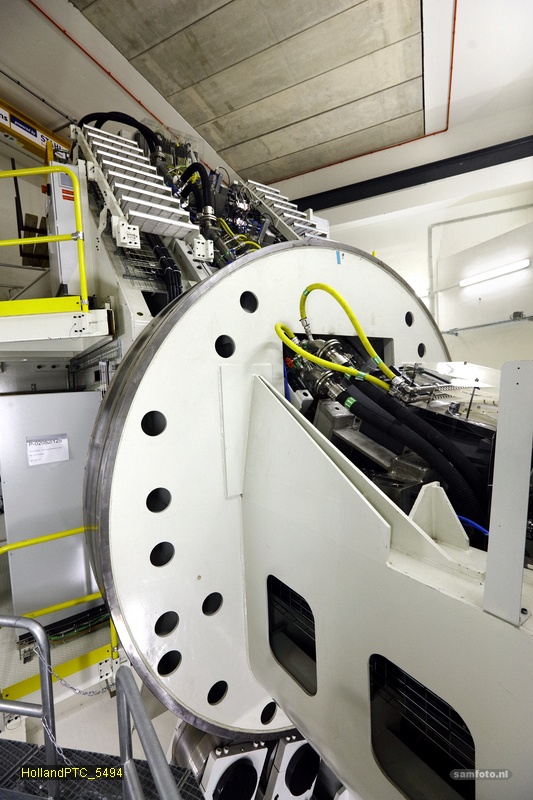 The proton bundle is produced by a so-called gantry, a machine with a diameter of nine metres. This circular colossus can rotate 360 degrees around the patient. (Photo: Sam Rentmeester)
The proton bundle is produced by a so-called gantry, a machine with a diameter of nine metres. This circular colossus can rotate 360 degrees around the patient. (Photo: Sam Rentmeester)In the middle of the room is a robot arm, originally from the car industry. An examination table will be fixed to the arm, onto which the patient will be secured. The arm will then be able to move the patient in two directions: firstly into the CT scanner to visualise the tumour again, and then under the proton bundle.
The proton bundle is produced by a so-called gantry, a machine with a diameter of nine metres. This circular colossus can rotate 360 degrees around the patient. It uses magnets to focus the protons on the tumour with the greatest possible accuracy.
Patients do not see much of the machine, only a tip protrudes into the treatment room. “Some finishing touches are still to arrive from BMW,” says De Spaey. BMW, the car manufacturer? “Yes, they helped design the space.”
Holtzer opens a door next to the treatment table. We arrive in the back of the space with the towering gantry. “In Baltimore, the doctors show this machine to the patients,” says Holtzer. “It gives them the feeling that they are in good hands. Perhaps we will do the same here.”
Do you have a question or comment about this article?
tomas.vandijk@tudelft.nl

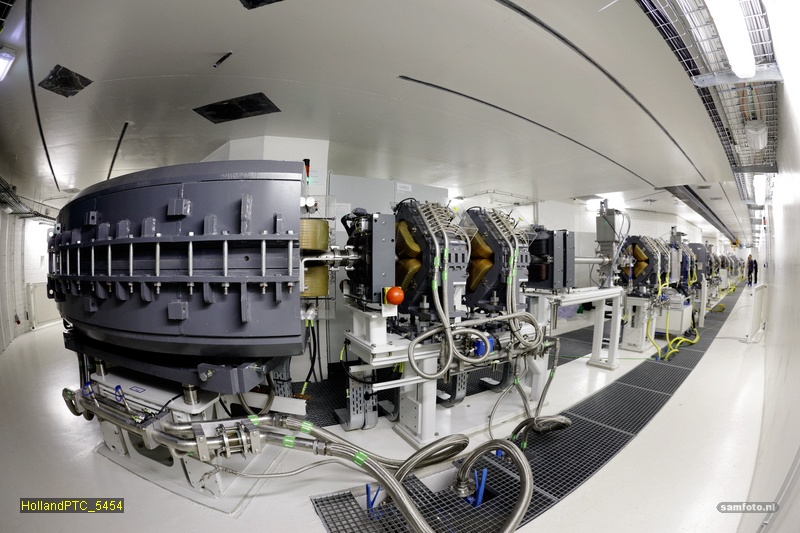
Comments are closed.